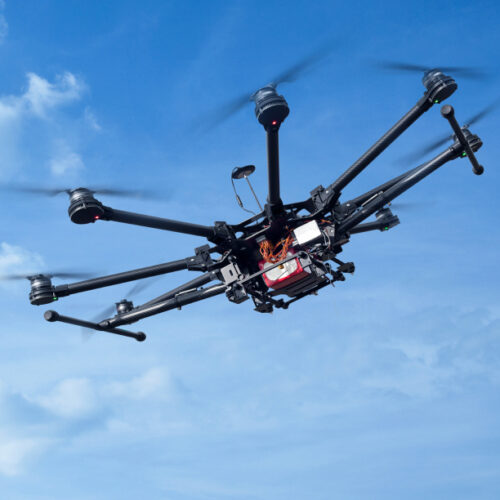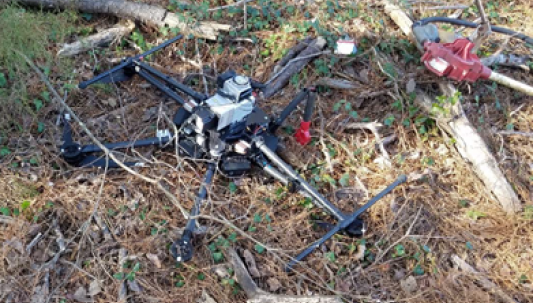ARTICLE
Drone Insurance

HELP! I CRASHED MY DRONE! Do I have insurance coverage for this?
You have been hired to perform an aerial survey of a wooded site. The site is expansive and will require 3 days to survey. On this day in late October, the sky is clear blue with no rain in the forecast. Conditions are perfect for your 4-person drone crew, consisting of a pilot, flight controller, and two visual observers. The drone executes its mission without issue until the return leg of the flight plan when it makes a hard, uncontrolled landing . . . CRASH! The unmistakable sound of the drone falling through the trees can be heard by the crew. Luckily, no one is hurt and no property other than the drone itself are damaged. The crew performs reconnaissance to recover 99% of the drone and LiDAR sensor parts; only 2 blades from the rotors cannot be found. Upon closer inspection, the drone itself is obviously going to be a total loss, but the more expensive payload seems to have held up well.

Hopefully you bought insurance and maintained a good relationship with your vendor and/or manufacturers. All these resources will provide assistance to get your drone operations back up and running to mitigate impending financial loss resulting from the drone crash.
Here are your next steps:
- Contact your insurance broker, who will put your insurer on notice of a claim.
- Start collecting the following items, which may be requested by the insurer in adjusting the claim:
- Written account of the events that led to the crash including date/time of loss, contact info, drone/part serial numbers, and witness information
- Pilot’s Part 107 License (recurrent exam results if license is more than two years old)
- Copy of the purchase agreement
- Flight log data
- Estimate(s) obtained to repair damage and/or replace
- Notify your drone vendor and/or the manufacturer directly as they will be needed in order to obtain the last 2 items above. The drone manufacturer will be able to retrieve the flight log data to determine the cause of the crash. Both the drone and payload manufacturers will most likely be responsible for repairing and re-calibrating of the equipment in order to maintain any warranties.
- Review your contract with your client. What are the delay notification provisions and is the drone crash excusable or not?
Site Safety and Raising the Standard of Care
On a construction site, the General Contractor is responsible for site safety. Architects, Engineers, and other Construction personnel on a site are expected to notify the General Contractor of any unsafe conditions they observe and act if a person is in immediate danger. If a drone is regularly taking pictures or videos of a site that capture evidence of a site safety issue or a defective condition, is the custodian of that drone and its work product on notice of the condition? Engineers, for example, may have an ethical duty to immediately report site safety issues and a contractual obligation to report to the owner defective conditions that they knew or should have known of. If they do not, there may be liability ramifications. A drone may raise the expectations of an owner that defective conditions will be found, thereby raising the standard of care when drones are used. Consider a bridge inspection where drones can now easily see areas of a bridge that were either difficult or impossible to see before this technology. The public now has increased expectations of bridge safety, so if there is a bridge failure, even more scrutiny will be placed on the engineer that did not observe an issue by using a drone. Conversely, if an engineer does not identify corrosion of back welds when using a snooper truck is the standard of care violated when a drone easily could have seen the issue?
What happens next?
Privacy Violation
Maintaining privacy can be a real issue when it comes to drones. Although the drone is being used to perform a certain mission, it may inadvertently capture information outside of its scope. The intended mission may also come into question given that a drone may be able to capture information someone is trying to hide. In the case of Long Lake Township v. Maxon, the 4th Amendment came into question, which protects people from unreasonable searches and seizures by the government. The Township had hired a drone operator to determine if an illegal salvage yard had been created on the Maxon’s property, which resulted in a civil action against the property owner where photographs from the drone were used as evidence. On appeal, the State of Michigan published an opinion that “persons have a reasonable expectation of privacy in their property against drone surveillance, and therefore a governmental entity seeking to conduct drone surveillance must obtain a warrant or satisfy a traditional exception to the warrant requirement.” In this case a warrant would have allowed the Township to perform a legal search of the property. Land disputes can also be hotly debated between hostile parties where one may be tempted to hire a drone operator to collect evidence. Since a drone is not allowed to fly over people that are not actively participating in the operation of a drone, it is therefore important to obtain site access agreements from adjacent sites when performing drone flights. The two policies that respond to privacy concerns are:
- Personal Injury coverage of a drone policy will protect an insured from false arrest, detention, or imprisonment; malicious prosecution; wrongful eviction; slander; libel; and invasion of privacy (https://www.irmi.com/).
- Network and Privacy (Cyber) Liability provides protection if confidential information is accessed during a flight or via stored information on your servers or in the cloud.
In determining causes of drone malfunction, Bobby Watts, owner of drone manufacturer Watts Innovations says most of what he has seen is user error. However, each time there is an incident with a drone, the manufacturer will look at the cause and try to prevent a similar event from happening, user error or not. Drone technology is constantly evolving with commercial use of drones in the Architecture and Engineering industry occurring within the past 10 years, which means user and manufacturer are both still learning. The drone manufacturers will typically warranty the performance of the drone outside of user error, so exclusions like electrical malfunction on an insurance policy may be covered by your manufacturer’s warranty.
No matter the intensity of the crash, LiDAR sensors will need to be recalibrated in order to accurately perform on future flights. My-Linh Truong, Unmanned Division Manager of RIEGL USA says depending on severity of impact, that typical turnaround time once received at their facility in Austria can be a matter of weeks.
Physical Damage coverage is the part of a Drone insurance policy that will respond in the above scenario. This coverage extends to the hull (drone), the payload (sensor, camera, etc.), and the ground equipment (controls, batteries, etc.). All the above is scheduled onto the insurance policy, so you can pick and choose what you want to insure. Any equipment acquired in the middle of a policy year would need to be endorsed onto the policy, unless you can secure “blanket” coverage, which does not have the same administrative burden of scheduling all changes mid-term. Premium for Physical Damage coverage can range from 7-10% of the value of the drone and payload; 1-3% for the ground equipment. Deductibles vary from 5-10% of value.
A scenario that is most likely to create a severe loss is when a 3rd party is involved. For example, if the drone had crashed into a car driving down the highway, both property damage and bodily injury could result. Liability coverage of a drone policy would respond to this situation. Limits for this coverage from an insurer typically range from $1M-$5M+. At the $5M mark, a separate Umbrella insurer will typically extend their policy over that of the drone policy. Premium for the liability coverage on a drone policy is about $400-$500 per drone.
License Requirements to Perform Surveys
A consideration when subbing drone work is the qualifications of the drone operator. Some state professional organizations are starting to pass laws and bring disciplinary action against unlicensed companies when performing aerial surveys. Professional Liability is a common coverage carried by an engineering company, but it is not as prevalent by companies who only perform drone work. If a claim for negligence is alleged, the engineer that hired the drone operator may be left holding the liability as the firm that has the bigger pocket. As laws vary by state, check with the state where the drone work is being performed to see if a professional license (i.e., registered land surveyor or professional engineer) is required. If it is, require any drone sub to maintain professional liability as well.
- Drone liability including your company as an additional insured on a primary and non-contributory basis with waiver of subrogation against your company.
- Contractual requirement for the drone operator to hold you harmless from any damage to the drone while in contract to you.
- Workers Compensation
- Professional Liability (see Risk Management Consideration #3)
- Cyber Liability (discussed below)

Our Recommendation
AUTHOR

KRISTEN WALKER, CRIS, LEED
Kristen is a client executive and broker with Greyling, a division of EPIC. She is experienced in the unique coverage needs of both contractors and design firms. She works with mid-sized to large clients, many with global exposure and complex insurance programs.
Kristen founded the Greyling | EPIC sponsored Women in A/E/C Networking Events that provides a forum for relevant industry topics to be discussed by leading and up-and-coming women in a relaxed environment.
Kristen joined Greyling in 2012. Prior to that, she was a Senior Underwriter at Zurich focusing on both project and practice professional liability policies for owners, contractors, and designers. Kristen holds Construction Risk and Insurance Specialist (CRIS) and Leadership in Energy and Environmental (LEED) Green Associate designations.